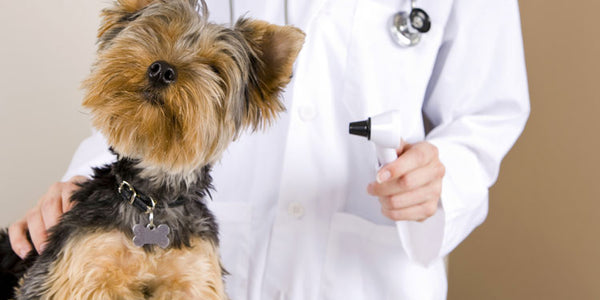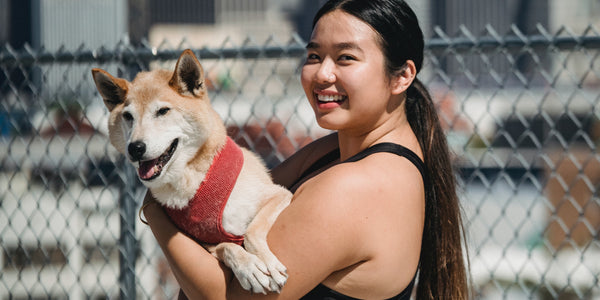‘My dog ate my homework’ isn’t just an age old excuse for not handing up work. In fact, cats and dogs are always notorious for gobbling up things they shouldn’t! However, as good pet parents, we should know that our pets ingesting or swallowing foreign objects can be very dangerous. In some cases, it can even lead to serious health issues or death. So, if your pet swallowed a foreign object or is prone to chewing, biting or ingesting one, here’s what you should take note of!
Foreign Objects Commonly Swallowed By Pets

What are some of the most commonly swallowed foreign objects? Well, generally any household item within your pet’s reach can easily be ingested. This is especially so if your cat or dog is particularly inquisitive or really enjoys chewing things.
In most cases, dogs are the ones that are likely to consume non-food items. However, cats still have a tendency to ingest string-like items due to their fascination with ribbons, strings, and other dangly objects.
For example, here are some of the most common items pets end up swallowing:
- Food waste (such as corn cobs, fruit pits, teriyaki sticks)
- Food wrappers as well as other plastic items
- Bones
- Small toys (such as balls, rubber toys, string toys or parts of it etc.)
- Paper
- String-like objects (such as hair ties, ribbons or dental floss)
- Fabric (such as socks, pieces of rugs, bedding or other linen)
- Feminine products
- Small items (such as silica gel packets, coins, batteries, rocks or jewelry)
Symptoms Of Foreign Object Ingestion
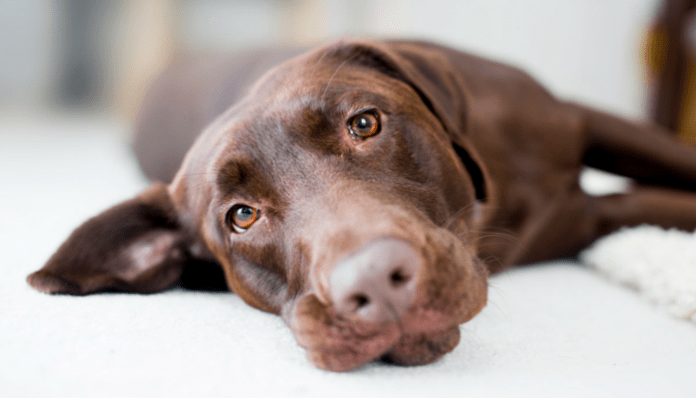
What happens when your pet swallowed a foreign object? Most of the times, foreign objects end up obstructing your cat or dog’s gastrointestinal (GI) tract. Hence, if you suspect your cat or dog has swallowed a foreign object, first look out for the following signs:
- Excessive drooling
- Choking or gagging
- Decrease in appetite as well as a refusal to eat
- Diarrhea
- Vomiting
- Lethargy
- Straining to defecate
- Abdominal pain
- Changes in behaviour (such as growling, hissing or biting when picked up or touched near the abdomen)
If your pet does not show any of the following symptoms in the next few hours, and did not ingest anything dangerous or harmful mentioned below, they should be relatively fine. However, it might still be good to give your vet a call.
What Happens When My Pet Swallows A Foreign Object?
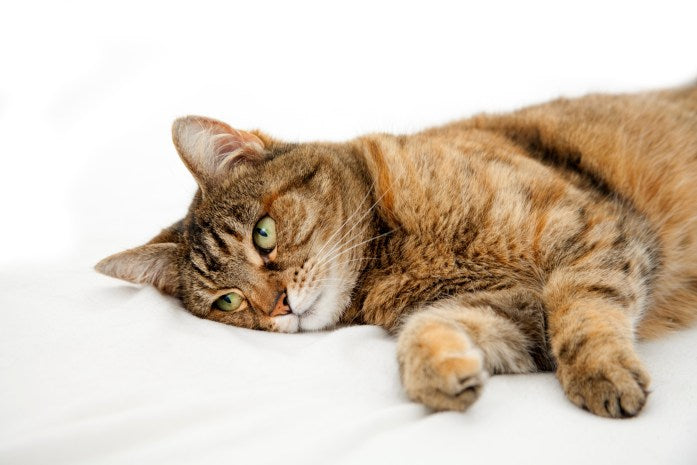
Swallowed foreign objects can be roughly classified into five categories based on their potential effects in the GI tract.
Small Objects
Smaller items (that aren’t sharp, string-like or toxic) are usually able to safely pass through your pet’s GI tract without any damage or major issues. In addition, your pet may even consume an item and pass it without your knowledge. This includes items such as a small piece of plastic from a plastic bag, a small pebble from gravel or a bit of paper. However, do note that this depends on the size of the object as compared to the size of your pet.
Large Objects
Generally, large items are not safe when swallowed. If they do not cause your cat or dog to choke, they often become lodged somewhere else below the GI tract (such as the stomach or intestines). This obstructs food from passing through, causing intestinal blockage.
Swallowing many objects can cause this — ranging from items such as tennis balls, dog toys, large amounts of toilet paper* all the way to silica gel packets* and corn cobs.
*These items can also absorb moisture, which may cause dehydration.
Sharp Objects
Sharper, harder objects are even more dangerous when ingested. As they pass through the GI tract, they may cut into your pet’s mouth or damage organs, subsequently causing gastrointestinal perforation. A hole in the intestines or stomach can result in life-threatening issues such as sepsis or peritonitis.
Therefore, we need to be especially cautious to ensure our pets don’t get their hands on objects such as aluminium, sticks, broken pieces of hard plastic toys, rocks or jewelry. It is also crucial that you do not give your dog cooked bones, as they can easily splinter. If you’d like to learn more about feeding your dogs bones, check out “Is It Safe To Feed My Dog Bones?”.
String-Like Objects
String-like objects are also called linear foreign bodies. As one end of the string can be wedged in the stomach or esophagus and the other end in the small intestine, it can cause the small intestine to bunch up. When it bunches up, it can result in the string cutting into the small intestine, which leads to gastrointestinal perforation.
String-like items most commonly swallowed include household objects such as rope toys, hair ties, ribbons, dental floss, socks, linen, bedding and even feminine products.
Toxic Objects
Items such as batteries or cigarettes can not only be easily lodged — they are also highly toxic when swallowed. For example, if a battery is chewed or punctured, it can leak caustic substances that can corrode and burn the GI tract. In addition, ingestion of cigarettes can also cause nicotine poisoning in cats and dogs.
Important — Take Note If Your Pet Swallowed A Foreign Object!
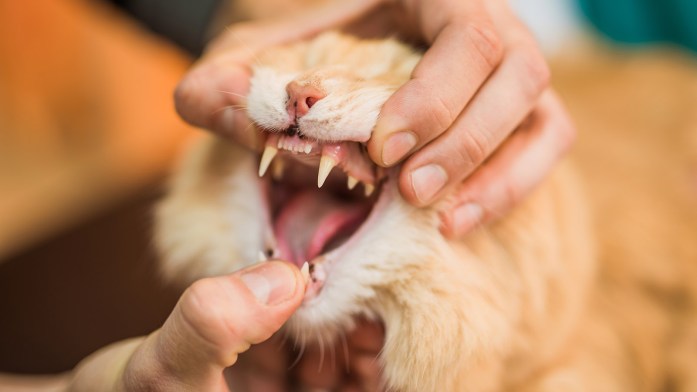
If there is something stuck deep in your pet’s throat, do not pull it out (or cut it if it is a string) even if you can see it. It is also unwise to try inducing vomiting in your cat or dog by yourself, as it can make the situation worse. Please bring your pet to the vet in such cases.
However, if your cat or dog is choking, it is crucial that you take action immediately. If possible, try removing the lodged object in the mouth or throat. If not, get your pet to an emergency vet as soon as possible or perform the Heimlich maneuver if you know how to.
Heimlich Maneuver For Small Dogs
- Lay your dog on their back.
- Use your palm to apply pressure just below the rib cage, pushing inwards and upwards.
- Finally, check your dog’s mouth for the food or object that they were choking on.
Heimlich Maneuver For Medium to Large Dogs
If your dog is standing:
- Put your arms around the belly so your hands clasp at the abdomen.
- Make a fist and push firmly inwards and upwards right beneath the rib cage.
- Check their mouth for the dislodged object.
- Finally, lay your dog on their side to rest.
However, if your dog is lying down:
- Place one hand on your dog’s back for support.
- Use the other hand to push upwards and forwards (towards the spine) right below the ribcage.
- Finally, check their mouth for the dislodged object.
Heimlich Maneuver For Cats
- Lay your cat on the side.
- Place one hand on your cat’s back for support.
- Use the other hand to push upwards and inwards just below the ribs.
- Finally, check their mouth for the dislodged object.
If your pet is still not breathing after it is removed, check for a pulse. If no pulse is detected, start CPR or artificial respiration while seeking veterinary help immediately. Even after removal, we still advise you to contact your vet as the object might have damaged your pet’s mouth or throat in the process.
Treatment For A Pet That Swallowed A Foreign Object

If you suspect that your pet has swallowed foreign object (that might be harmful), or are showing the symptoms, do contact your vet immediately.
Your vet will perform an X-ray, where they will most likely be able to deduce what the foreign object is and where it is in the GI tract. The vet then is able to determine the best treatment. However, if it does not show on the X-ray, your vet may look at other indicators of obstruction like gas patterns, or give your pet a liquid contrast dye that helps the foreign object show on X-rays. Blood work may also be done.
Monitoring

Generally, if the item is non-toxic, small with no sharp edges, and does not seem to be obstructing the GI tract, your vet might simply continue to monitor your cat or dog as no endoscopy or surgery is required. This is especially so if the item is already in the large intestine, as it is very likely to pass naturally.
In addition, if there is some obstruction but the pet is not doing too badly, IV fluids can be given in some cases to help them pass the foreign object naturally. In such cases, vets will use multiple X-rays or ultrasounds to monitor the situation. If it can’t be passed, endoscopy or surgery is then performed.
Endoscopy
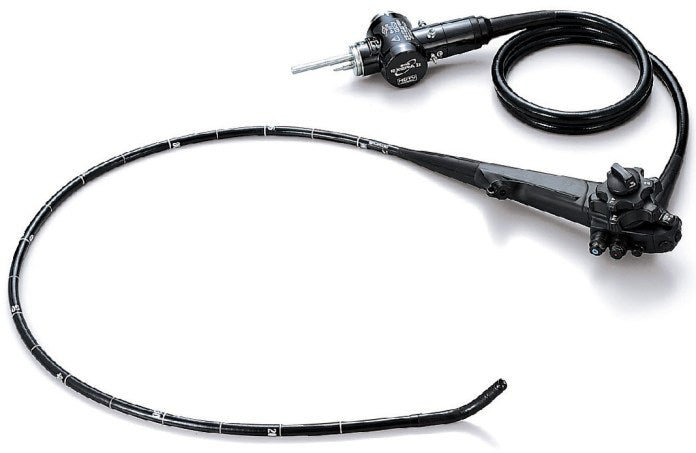
Endoscopy is the insertion of a thin, long tube through the mouth or anus to observe the digestive tract. It is also a safe and effective method (with long forceps) for pulling out foreign objects in cats as well as dogs.
Endoscopy is used when the foreign object is still in the esophagus or stomach. However, if the object is wedged too tightly, or the item is too smooth or slippery (e.g. rubber balls), surgery might still be needed as it cannot be pulled out.
After endoscopy, treatment or surgery might still be needed if the esophagus or stomach lining is inflamed or thinned, or if there is an ulcer or hole.
Surgery
For cases where there is perforation, such as a tear or a hole, surgery is needed. In addition, if a linear foreign body, such as string or linen, is in the small intestine, your pet would require surgery. This is because linear foreign bodies cannot be pulled out with the endoscope, as it may cause further tearing of the intestine.
Treatment can vary from simply removing the object from their mouth to performing gastrointestinal surgery that may require the removal of large portions of bowel. Hence, the potential severity of a swallowed foreign object like a corn cob or sock should not be underestimated.
Prevention
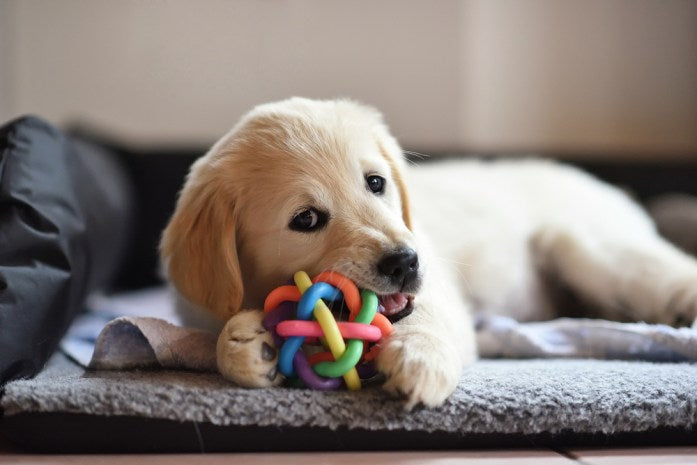
As swallowing foreign objects can be very dangerous for pets, prevention is always key! Read the following tips to help prevent your pet from ingesting something they shouldn’t:
- Clean up all your trash (especially food waste) immediately.
- Keep trash bins out of your pet’s reach.
- Remove children’s toys from the floor, or restrict your pet from the toy area.
- Keep pets out of places such as the craft room, tool box or workspace.
- Store all string and yarn out of reach or in a pet proof container.
- Avoid decorating with string-like objects such as tinsel or ribbons during holidays.
- Try not leave your pets unsupervised with toys or chews.
- Throw away toys as soon as they are broken.
- For pet parents with dogs, do not give your dogs any cooked bones.
If you’re looking for some pet-proof containers to store food as well as other items, consider Lock & Lock.
In addition, if you want a better alternative to cooked bones, try tasty dog chews or raw bones instead.
If you would like to read more pet care-related topics, check out “Things We Should Not Be Feeding Our Cats” or “Top 11 Things Not To Feed Your Dog”.




